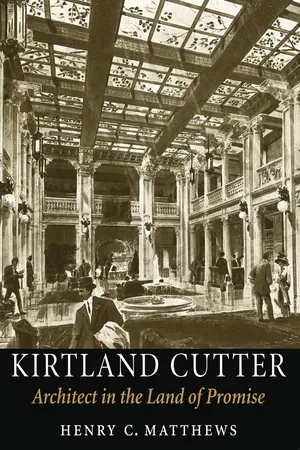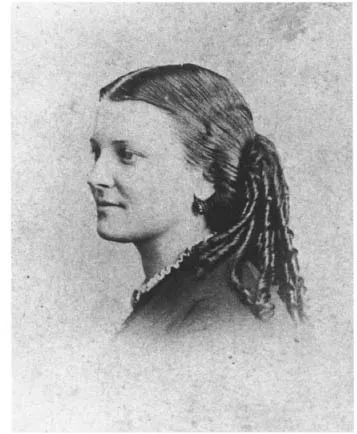![]()
CHAPTER ONE
Whippoorwill Farm
KIRTLAND KELSEY CUTTER WAS BORN AUGUST 20, 1860, in the village of East Rockport, near Cleveland, Ohio. He spent his first seventeen years at the home of his mother’s grandfather, Jared Kirtland, a distinguished physician and naturalist. His father, William Lemen Cutter, a prosperous bank official, and his mother, Caroline Atwater Pease, both came from pioneer Ohio families. His parents must have felt a deep involvement with the thriving city of Cleveland, for so many of their ancestors had played important roles in its founding and development. Their marriage linked families active in business on William’s side and distinguished in the learned professions on Caroline’s. They brought into the world a child so well provided with enterprising and successful relatives and ancestors that he had no reason to doubt his own worth or question his ability to achieve his ambitions. Joined by his sisters Laura in 1862 and Caroline (known as Caddie) in 1866, he benefited from the company of four generations of his family.
His mother’s forebears on both sides had been among the first explorers, settlers, and public officials of the Western Reserve. Her great-uncle Seth Pease accompanied General Moses Cleveland on his first expedition in 1796, as a surveyor and astronomer. The next year he laid out the plan of Cleveland with a grid of wide streets and a public square.1 Seth’s brother Calvin, her grandfather, helped to establish law in the new territory. He began his career from a log cabin, and as a circuit judge rode over rugged terrain between distant townships. Family legend claims that to carry out his duties he made a point of choosing horses that could swim well. At the peak of his professional life he became chief justice of the Ohio supreme court.2
1.1 William Lemen Cutter, Kirtland’s father. Photo by J. F. Ryder. Eastern Washington State Historical Society, L94–60.2.
1.2 Caroline Pease Cutter, Kirtland’s mother. Photo by Green of Schwerdt, Cleveland. Eastern Washington State Historical Society, Peggy Bayless Collection, L94–60.3.
In 1798, Caroline’s great-grandfather on her mother’s side, Turhand Kirtland, had also led a survey party to the new territory. Born in Wallingford, Connecticut, where his family had farmed since arriving from England in 1633, Turhand became one of the founders of the Connecticut Land Company, which purchased title to the Western Reserve. He made the arduous boat journey west several times with parties of emigrants via the Niagara River, hauling boats around the falls and reaching the future state of Ohio by Lake Erie. Settling permanently in Poland, Ohio, in 1803, Turhand worked as an agent of the company, selling tracts of land, promoting settlements, and “introducing schools and various improvements.” He gained respect among the settlers, who elected him a judge and then a state senator.3 The house he built for himself in Poland still stands, a witness to the simple elegance and good proportions of the Federal Period.
When Turhand left New England, his young son Jared Potter Kirtland (1793–1877) stayed behind in Connecticut to be educated by his grandfather, Dr. Jared Potter, a pioneering physician who kept a medical school. Potter became his mentor and taught him to question common beliefs. Under his tutelage Jared became an acute observer of nature, and even as a young man carried out original research in botany and entomology.
At the age of seventeen, summoned west because of his father’s ill health, Jared rode to Ohio with two companions. Excited by the unfamiliar flora and fauna he found along the way, he took notes, even stopping at the lakes to dissect fish specimens that were new to science. By the time he finally arrived in Poland, Jared found that his father had recovered from his illness. He spent the next year there teaching school and recording scientific information about his new surroundings.
When his grandfather, Dr. Potter, died leaving him his medical library and enough money to attend medical school, Jared enrolled at Yale University and followed in his benefactor’s footsteps, practicing medicine in Wallingford and studying the natural world. He was described as “a veritable human worm, boring his way to knowledge by a precocious system of analysis and investigation applied to everything he touched and saw.” On the death of his wife and one of his daughters in 1823, he returned to Ohio to join his father and soon became one of the leading medical men and scientists in the West, passing on his knowledge to many doctors, farmers, and naturalists. He possessed an irresistible personal magnetism that inspired others: “The man who came to him with a stolid contempt for book-learning and with no sense of the beautiful as distinct from the profitable left him with higher views and nobler impulses. With an art beyond all art, because it was nature, the clod, the miser, were lured out of themselves and brought to see the world through the eyes of a magician.”4
This was the man who helped guide young Kirtland Cutter through his formative years, who taught him observation, analysis, and the appreciation of natural beauty. By the time the two were together at East Rockport, Jared had risen to a position of eminence with many achievements to his name. He served three terms in the Ohio State Legislature, and assisted in the geological survey of Ohio. He became professor of theory and practice of medicine at the University of Cincinnati and later at Cleveland Medical College, which he helped to found. He was also a founder of the Cleveland Academy of Sciences and the author of a catalogue of the mammals, birds, reptiles, fishes, and mollusks of the state, complete with his own drawings. As an expert taxidermist he prepared specimens for his own vast collection as well as for other institutions, including the British Museum. Although an active member of many national learned societies, he was always ready to give time to private pupils and to his great-grandson. His advanced age was apparently no impediment.5
Jared Kirtland’s greatest pleasure was in his model farm at East Rockport. In 1840, tired of living in the city, cut off from the natural phenomena he loved to observe, he had purchased eighty-three acres on the shore of Lake Erie. Here he built Whippoorwill Farm, a modest house of stone dredged from the bed of the Rocky River two miles to the north.6 He surrounded it with a large, private arboretum stocked with many species of trees, including magnolias of spectacular size. Over many years, he carried out experiments in the cultivation of fruit trees and developed new varieties best adapted to the climate.7
Young Kirtland Cutter spent happy hours on the farm, in the orchards, and in the arboretum on the edge of the lake. He could also explore the private museum where Jared kept his outstanding natural history collection. In a letter, his great-grandfather described him at the age of ten “as being of bronze molasses color with his frame rapidly developing in height, breadth and grace into the model of Abram Lincoln. His time is mostly spent out of doors on the farm, and the hens, turkies, rats and mice all are embraced in his charge and jurisdiction, snakes and fishes included.”8
Years later, Kirtland Cutter admitted that when he was young he had wanted to be a naturalist himself, and acknowledged his debt to his great-grandfather.9 No doubt the old man loved to explain for him the mysteries of nature, and it may have been under his tutelage that the boy did his first drawings. With scholars coming from distant places to visit the “sage of Rockport” and so many phenomena to awaken a sense of wonder, Whippoorwill Farm must have seemed a very important place in a rich and intriguing world.
It was also a place where moral values and humanitarian concerns could be absorbed. Jared Kirtland was not a religious man; he had acquired a skepticism from his mentor, Dr. Potter. However, he was a man of strong moral convictions who believed in the fundamental rights of the individual. He spoke out vehemently against the execution of John Brown, volunteered at the age of sixty-nine to assist as a doctor in the Civil War, and pioneered legislation in penitentiary reform.10
1.3 Kirtland Cutter as a child. Eastern Washington State Historical Society, L85–174.2.
His obituary in the Cleveland Herald portrays him as a veritable Saint Francis of the Middle West: “He was a diligent student of nature, and nature repaid him in a charming way. The birds, the bees, the insects, the trees he planted, tended, and engrafted with his own hands, the flowers, and the grasses under his feet, all seemed to know and love him. . . . Amidst swarms of bees he went unharmed and the very birds around his dwelling scarce moved at his approach.”11
1.4 Dr. Jared Potter Kirtland, Kirtland Cutter’s great-grandfather. Painting by Allen Smith. Cleveland Museum of Art, Neg. 1397.
Jared Kirtland’s daughter Mary Elizabeth married Charles Pease, the son of Judge Calvin Pease. Charles did not follow family tradition by studying for a learned or scientific profession, but entered the world of business and became involved in property and railroad development. His success enabled the family to live in comfort and prosperity. In 1836 the couple moved from the Pease home at Warren, Ohio, to Cleveland, and in 1850 they joined Jared Kirtland at Whippoorwill Farm, which they helped to rebuild.
Mary Elizabeth gave birth to four children, two of whom survived childhood: Charles and Caroline, Kirtland Cutter’s mother. Uncle Charles, who also lived at Whippoorwill Farm, carried on the family tradition as a naturalist and explorer. In 1862 he joined a party of young naturalists from the Smithsonian Institution to explore the Yukon River in Alaska. After the members of the expedition had endured “all manner of hardship and privation,” the leader died and it fell to Charles to bring his body back, over eight hundred miles “by the water of the great lonely river.” He “earned the proud title of being the first American, if not the first white man, who had ever passed down the great flood of the Yukon to the sea.”12
While the Pease and Kirtland families gained their prominence through achievements in law, science, and the exploitation of land, the Cutters were involved in trade and commerce. But they too had played a part in the opening of the Western Reserve, and like the Peases and Kirtlands they belonged to old American families whose ancestors had come from England in the early seventeenth century. Orlando Cutter, Kirtland Cutter’s paternal grandfather, certainly had tales to tell about his life and adventures as a pioneer, but he could also offer the young boy words of wisdom about hard work and honesty.
Orlando was born in New Hampshire, but moved to Boston where he worked for “a large jobbing house.” He must have made an exceptionally good impression on his employers, for when he was only twenty-one they “offered him credit for dry goods to the amount of ten thousand dollars, with which to go West to seek his fortune.” Orlando decided to make a preliminary trip to select a suitable place to open a business. He borrowed four hundred dollars and set off on horseback in the spring of 1818: “He started with a pair of well-filled saddle bags as an outfit, and in due time arrived in Cleveland. He reached this city by water on the 30th of June 1818, having spent nine dismal days on the schooner Ben Franklin, en route from Black Rock. . . . Cleveland then contained but two hundred inhabitants and four stores. Water Street was the only thoroughfare to the lake that was cleared sufficiently for travel. . . . Twenty or thirty teams driven by Germans from Pennsylvania . . . were encamped in Superior Street on the night of Mr. Cutter’s arrival and they gave the town such a business-like...




